The houseplants Cyperus Papyrus and Cyperus Alternifolius are commonly known as Umbrella Grass, Umbrella Plant, Umbrella Papyrus, Umbrella Sedge or the Umbrella Palm.
Outside they make great pond plants. But they're also fast growing easy to care for houseplants. They just need reasonable light and lots and lots of watering.
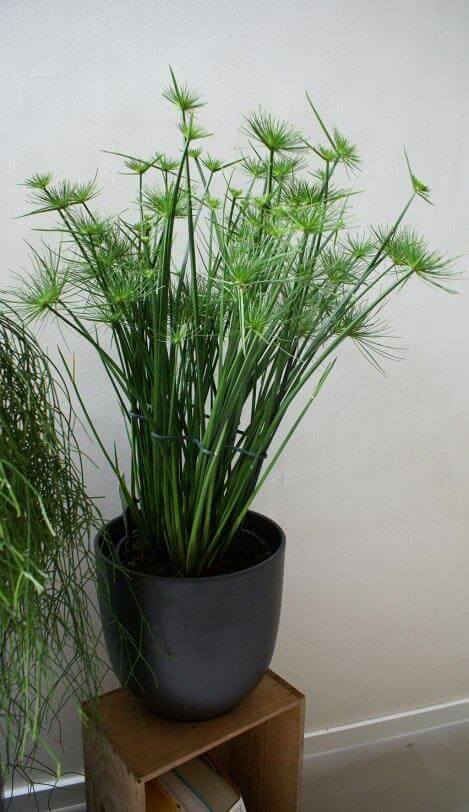
Papyrus plants are grass-like plants that make super simple houseplants. - Photo by Robin Berthier.
The Umbrella element of its various names comes from the leaflets that grow on top of the tall stems which (wait for it) look like the spokes of an Umbrella, giving an overall attractive and novel appearance.
With age the leaves and stems eventually form a grass-like clump, and this look is distinctly different to the other commonly grown Umbrella Plant i.e. Schefflera. In order to avoid confusion we're going to use Umbrella Grass as its primary name in our article, but all of the above names are equally valid.
This is one houseplant that is impossible to damage through overwatering.
This houseplant is very unique and its one of the only plants I've written about that can't (99% of the time) be finished off through overwatering.
Theoretically, Umbrella Grass is actually a pond or aquatic plant that resembles water reeds. It's very adapted to having its roots completely surrounded by water at all times and ultimately this is something that's needed if you want a good looking Cyperus. It grows just as well indoors as it does in a pond as long as you ensure the roots are kept constantly wet.
Although you must not underwater this plant at anytime, in all other ways Umbrella Grass is actually a very easy houseplant. It copes well with a range of light and temperature levels, grows quickly and is easily propagated. So if you become a fan it's very easy to grow more plants or give them away as unusual presents.
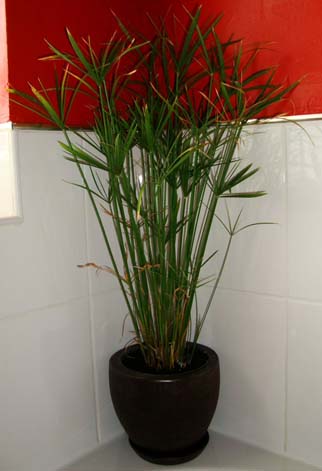
They have upright, slim leaves and stems. This creates a tall and elegant houseplant for a dull corner.
In some parts of the world the above traits have meant it's been classed as an invasive plant or weed, but on the whole and in the context of them being "houseplants" this is rarely a problem as they're neatly contained in pots.
There are various Cyperus species that are suitable for being grown indoors as a houseplants. The most popular ones today are C. papyrus, C. alternifolius (pictured left), and C. haspan (pictured above).
You may also find C. diffusus or C. involucratus in the outdoor garden plants section of garden centers. They can be grown indoors if you wish, but because they're very vigorous, bushy and somewhat untidy they're perhaps best suited to being grown outdoors in a pond or very boggy area in your yard. You may also come across the rare C. albostriatus variegatus which is highly attractive due to its variegated leaves.

Hi, I'm Tom!
If you're like me and enjoy the challenge of growing houseplants and getting them to thrive, then Ourhouseplants can help. This website shares my knowledge and years of growing plants and provides (hopefully) helpful advice on properly caring for your indoor plant friends.
Umbrella Grass can be grown equally well in full sun, bright light, light shade or medium shade. It's very adaptable and accommodating for the most part. If things are too dark it will tell you by producing very few new shoots or stems.
Can you overwater a Cyperus plant? Not really is the answer. Very simply you must provide a high level of water saturation at all times to keep your Umbrella Grass healthy and lush looking, so do try to keep the drip tray (or whatever the pot is sitting in) topped up at all times. If you choose a drip tray with a tall edge, you'll be able to reduce the frequency you need to top it up.
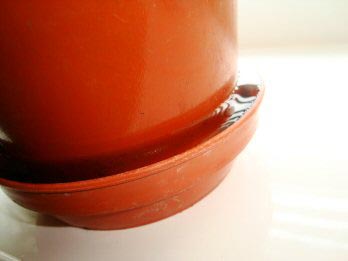
One of the few houseplants that really love being grown in standing water. Fill those drainage free containers or drip trays up.
Unlike many other houseplants the water requirement isn't something you can negotiate on as attempting to do so will quickly cause ugly effects with the arrival of brown splotches on the leaves or completely yellow / brown Umbrella Grass stems.
The only time you can cut back on the watering is if temperatures go very low, too much water at this point could cause damage through rotting. Additionally do not immerse the entire pot in water at any point for the same reason.
If you've followed the above instructions you can ignore humidity requirements as no additional humidity is needed. This is because the constant moisture at the roots will create a mini ecosystem and raise the humidity levels naturally around the plant.
Although it can produce a lot of growth, in comparison to bigger houseplants it will obviously not use as much feed. This means you only need to feed occasionally, perhaps once a month at standard strength when the plant is in active growth.
This is a plant that outdoors is quite hardy and this is mirrored indoors. A temperature range between 10°C / 50°F to 22°C / 72°F will be perfect.
Cooler temperatures down to around 4°C / 39°F are accepted for short periods. Be careful if things get too warm as this will cause a rapid drying of the soil resulting in more frequent watering.
You should look to repot the your Cyperus into a bigger pot using a high loam containing potting medium whenever it fills the current container completely and starts to become pot bound and this will usually end up being every few years.
Repotting once a year can be quite frequent for a houseplant, however there is a second reason for this and that is because of all the water constantly surrounding the roots and saturating the soil. Over time this will cause the potting medium to disintegrate so regularly repotting will renew what has been lost and provide fresh minerals and nutrients for the plant.
You can propagate Umbrella Grass in a number of ways. This can be from any seeds it produces (simply sow the seeds just under the soil surface, keep the soil wet and seedlings should start to appear in a few weeks).
Division (with a large sharp knife simply cut the clump into sections which can then be potted up separately to form new plants).
Or from cuttings, which we recommend and cover in more detail next.
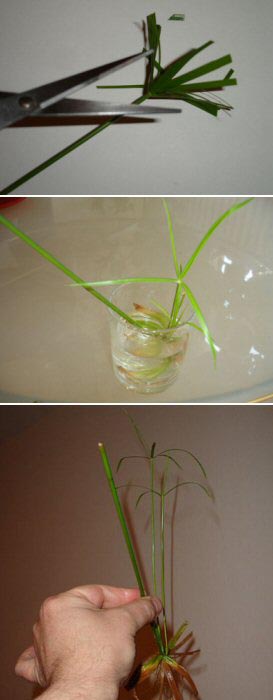
Cuttings are a reliable and efficient way of creating more plants without losing the bulk of the parent plant by dividing it. There are several ways of doing it but this is our favorite. - Photos by LucaLuca
1) Remove an entire stem and trim it so its around 10cm / 4in in length. Cut each of the leaflets at the top of the stem by just under half, as shown in the top picture.
2) Put the leaflets into a cup of water (can be tap, bottled or rain water it doesn't matter). This will mean the stem is upside down and sticking out of the cup. In a few weeks a brand new stem will form from the leaflets that are submerged in the water.
This new stem will grow rapidly and once it's free of the water surface new leaflets will appear along with a set of roots.
3) Once a new stem, or two, along with leaflets have formed and you can see a reasonable amount of root growth you can remove everything from the cup of water.
Cut the new growth free from the previous stem and leaflets (which you can then discard) and pot up into a potting compost. Within a few months there should be many more new stems growing and your new Umbrella Grass plant will already be quite a substantial size.
Umbrella Grass grows quickly when it's warm, light and ample water is provided. This is great when you are propagating or if you want something to fill a space quickly. It will slow down or stop growing completely when Winter arrives.
Depending what species and variety you choose, the end heights and spreads can be quite different, hopefully the plant you buy from a store will have these details with it. However if that's not the case, C. diffusus can reach 1m / 3ftm where as the more commonly sold C. alternifolius and C. haspan tend to be shorter peaking at around 50cm / 20in.
These plants will spread as much as the pot allows so if you have a very wide pot they will gradually move towards the edges and become wider.
You can get annual flowers on indoor Umbrella Grass plants, although they contribute very little to the overall appearance. They do indicate you are looking after your plant well though and add a little interest.
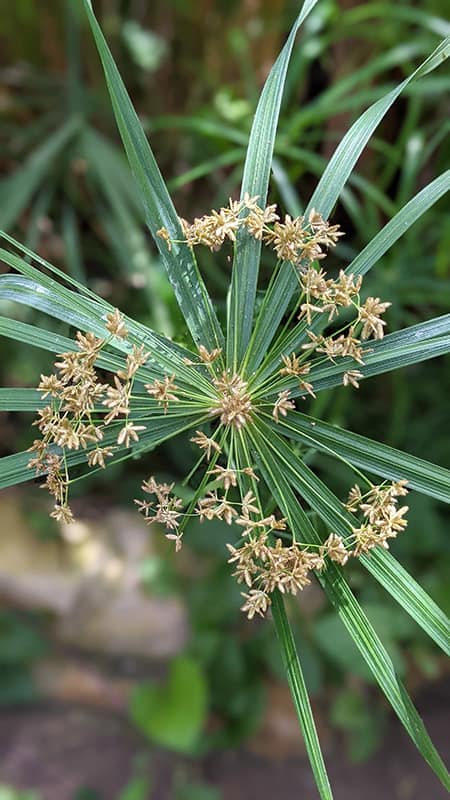
Mature plants will often produce flowers like these over the summer months.
You can consider taking any seeds that are produced if you want to try and propagate more plants in this way.
This is a reasonably uncommon houseplant so there isn't a great deal of information out there. While some pet owners say they've noticed their cats or dogs nibbling the leaves with no ill effects, it's still listed as slightly toxic by recognised experts.
This means that ingestion of these plants may cause minor illnesses such as vomiting or diarrhea. Keep your pets away just in case.
Two small things worth mentioning. Firstly the very tall varieties can become a little top heavy and floppy, so will benefit from some structure support. This is normally something like a wire ring or wire mesh around the plant towards its base, which stops it bending over and keeps its upright without looking too much of an eyesore at the same time.
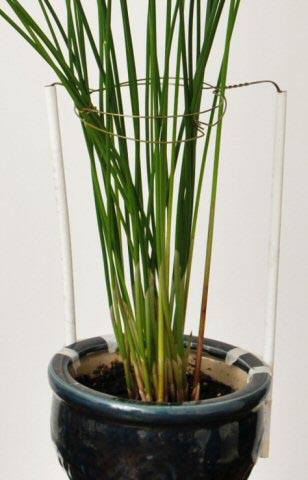
If your plant is drooping or spreading out in a messy way, use supports to keep the stems where you want them. Photo by HorsePunchKid
Secondly, very wet soil can encourage fungus or a stale stagnant smell, if you have this problem try adding small amounts of charcoal to the potting medium which should lessen odours caused by the souring compost.
Brown stems / Brown leaf tips / Yellowing leaves.
While Umbrella Grass is quite adaptable to the various levels of care you might provide, it's not at all forgiving if you don't water it enough.
Let the soil dry out only a little bit and it starts to get annoyed. If this is in any way prolonged you will get parts rapidly dying off. You must make sure the plant container is saturated or at the very least "moist" at all times.
Once the stems have gone brown, you have to pluck or cut them them out of the clump. It can be slow going, but oddly relaxing. The plant will look tons better when it's all green again.
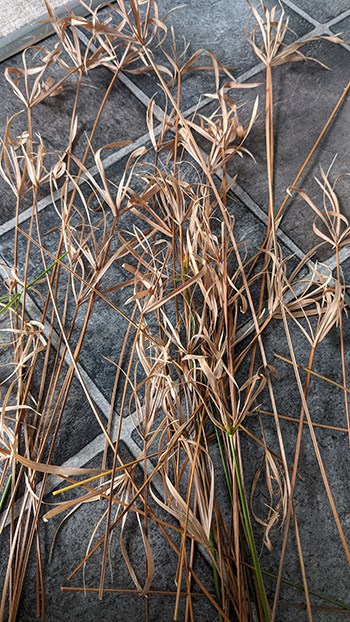
Cyperus is a water plant and must be grown in wet soil. If you let it dry out, this will be the result.
Little / no growth.
These plants are always growing in the warmer months of the year, so if they stop then something is certainty wrong. The most likely culprits are too little light or the temperature is too cold, it may also be time to repot your plant into a bigger container with fresh compost or a new potting mix.
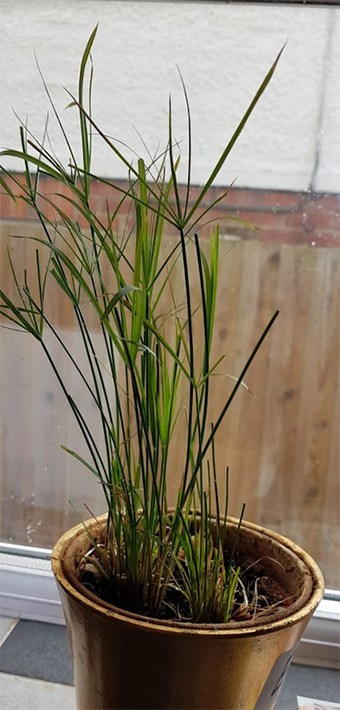
This plant may look healthy, but it's not grown in months. That's not normal and needs investigating.
Pests.
Many pests avoid highly humid areas so when things do go wrong your normal problems are usually rotting or disease. However if things with your plant don't seem right do check for pests such as Mealy Bugs and Green / Black Fly.
White mold on the soil surface / Sour smell / Mushrooms Growing.
All that water just sitting around when mixed with dank conditions and low ventilation can cause issues with the soil in which your Umbrella Grass is growing, such as rotten potting medium and white mold. Although it's fairly easy to sort out, to prevent it happening move your plant to a brighter spot and provide adequate ventilation.
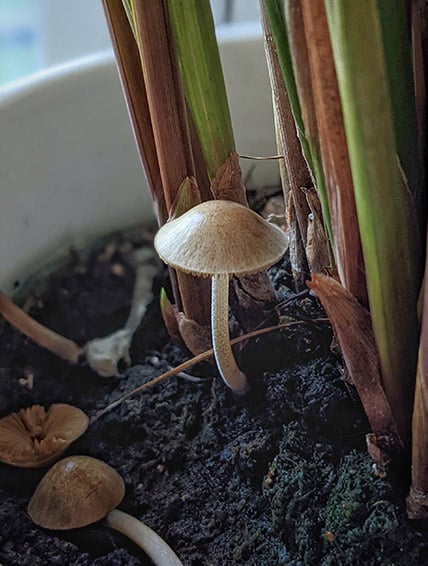
If you have mushrooms growing on the soil surface we have a more detailed article about mushrooms and potted plants that may help further.
I've cut the brown tips off but they keep coming back.
Weirdly if you cut the brown tips off completely, and cut slightly into the green growth below the edges can become brown again! Think of it like the plant version of a scab, if you make the ends raw it protects itself by creating a brown protective edge.
It's best therefore when you nip off any brown tips that you do so very carefully to leave just a small line of brown and don't cut into the green.
(Gallery) Cyperus flowers - Dbxsoul